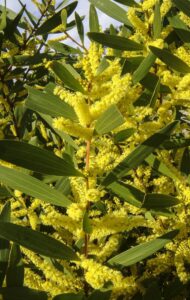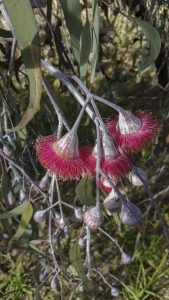Glenda Browne summarises recent queries about gardening with natives sent to our office email. Our group of experts responds.
Wildlife: Plants to attract kookaburras
Q: I was wondering if you could let me know what plants and trees attract kookaburras?
A: Kookaburras are not plant eaters, mostly eating lizards, fish, snails and insects, which they see from a perch and swoop down to catch, or root around in leaf litter. Sometimes they’ll swoop down and snag a sausage, as I saw last week!
They need a perch and suitable open ground. In my garden, when they sometimes come, they sit on a branch in open trees, so just having a natural type of garden, with understory and leaf litter to attract their prey would be fine. The bad news is that the tree planter may have to wait 100 years for hollows to form for the kookaburras to nest. Kookaburras adapt reasonably well to the human environment, so some people fed them, which may even lead them to catching smaller birds and chicks as prey.
Plant selection: Wattle tree
Q: Many years ago I planted a wattle tree, after much searching for the right one. It was bushy and screening and it grew to about 2.5 metres wide and high. Would you know the species I am talking about and where can I get them in Raymond Terrace (Hunter region)?
A: Some of the better wattles of around that size that can be found in the area are listed below. The first two are better for screening.
- Acacia longifolia (photo below)
- Acacia fimbriata dwarf variety
- Acacia elongata
- Acacia terminalis
- Acacia myrtifolia
Here is a link to a document that lists generally reliable plants for the Newcastle area – https://austplants.com.au/resources/Documents/Newcastle-Documents/Plant%20Guide%20Newcastle.pdf
Check acacias on our plant profile database here.

Plant selection: Mallee trees for Cessnock
Q: I have a property in the lower Hunter Valley south of Cessnock, and am interested in planting some flowering mallee trees and would like some advice on sourcing them. I am particularly interested in the following:
- Eucalyptus macrocarpa
- Eucalyptus rhodantha
- Eucalyptus erythrocorys (red cap gum)
- Eucalyptus websteriana
A: Well done – you have selected four spectacular small eucalypts, but they are all from Western Australia which makes them more difficult to obtain and harder to grow. The four trees grow in a winter rainfall area and the further up the coast of New South Wales you go the more summer rainfall happens. E. macrocarpa and E. rhodantha are particularly prone to fungal attack. E. erythrocorys and E. websteriana should be more do-able. Another option is the rare local endemic Pokolbin Mallee (Eucalyptus pumila). It is an attractive small mallee found on a couple of hilltops off the base of the Brokenback range near Pokolbin.
Bilby Blooms nursery specialises in mallees (and banksias and hakeas) from the arid interior and Western Australia. Because of frosts, they do not grow many E. erythrocorys, and chose to grow E. orbifolia over E. websteriana.
Plant care: Treating disease
Q: A neighbour of mine has a variegated pittosporum. Its leaves are yellowing, the flowers are dropping and the trunk has a white growth that oozes a creamy and then clear resin. Does anyone know what this disease is, and whether and how it can be treated?
A: It could be could be a fungal attack or bacterial canker. A variegated pittosporum is liable to stress because it does not have a full complement of green leaves capable of photosynthesis and is therefore not as resistant to fungal or insect attack.
One correspondent had noticed over the years that Pittosporum undulatum trees start to excrete large amounts of white sap, drop leaves and then eventually die. Whatever it is seems to take them out but it’s not clear whether the excreting is a symptom only. No NSW ecologists who were asked seemed to know what it was.
Plant care: Blueberry ash
Q: From Facebook: I have two Elaeocarpus reticulatus plants a few metres apart. One is dying from the trunk out – the outer leaves are OK, but the top and inner leaves are dead. What did l do wrong?
A: At the time of the question we had had a week of constant rain which was too much water for some plants. If the top foliage is dying that is a bad sign, because a healthy leading shoot is a good sign that the plant is growing and will keep growing. Even as close as two metres separation there may be different soil and drainage which could lead to different growth rates between plants.
Plant care: Caesium gungurru
Q: I live in Killarney Queensland. My gungurru tree is about 8 years old and has been growing and flowering beautifully despite being in an open position, subjected to heat, cold and wind. It’s growing with multiple trunks. A few branches have had very brown leaves over the past few months. On advice from a friend, I removed the branches when this first occurred. However it’s happening again, perhaps in response to extremely erratic weather of late. Should I remove the branches again or allow the tree to deal with it?
A: Gungurru (Eucalyptus caesia) is an attractive small tree to have in any garden. Your location is probably further north than its normal distribution and wherever I have seen the species. Eucalypts only maintain their leaves for two years, so foliage inside the canopy may be brown coloured before it drops. If the brown leaves on your tree are on the outside of the canopy then there is cause for concern. Check that the new leaves on the top of the tree are healthy. Many plants will respond to pruning with new growth and more flowers.

Thanks to John Aitken, Mark Abell, Ralph Cartwright, Rhonda Daniels, Alix Goodwin, Heather Miles, John Nevin, Merle Thompson, Dick Turner and our external correspondents.
Read more
Read more answers on native plants from our experts group here and here.
